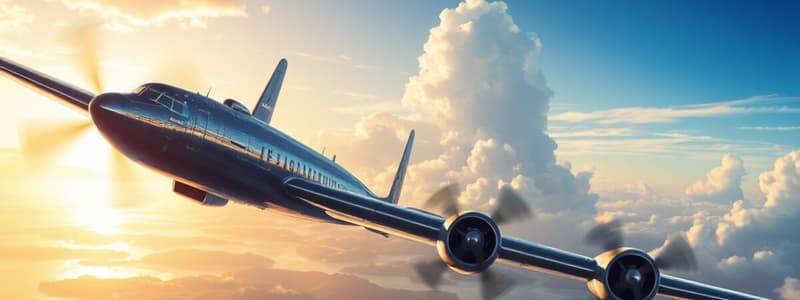Podcast
Questions and Answers
What meteorological challenges did the American bomber pilots face in the Pacific theater?
What meteorological challenges did the American bomber pilots face in the Pacific theater?
- Lack of wind and erratic weather patterns (correct)
- Constant thunderstorms
- Extreme cold temperatures
- High altitude snowstorms
What was a significant design flaw of the B-29 Superfortress?
What was a significant design flaw of the B-29 Superfortress?
- It could only carry a small bomb load
- It was susceptible to engine fires (correct)
- It lacked advanced navigation systems
- It was too heavy for most airstrips
The first major bombing raid (San Antonio One) involving the B-29 was targeting
The first major bombing raid (San Antonio One) involving the B-29 was targeting
- Mitsubishi Aircraft Company in Nagoya
- Civilian Populations in Sapporo
- Nakajima Aircraft Company in Tokyo (correct)
- Power Plants in Nakajima
What was the primary purpose of securing the Mariana Islands during World War II?
What was the primary purpose of securing the Mariana Islands during World War II?
What type of conditions did Marines endure during battles in the Mariana Islands?
What type of conditions did Marines endure during battles in the Mariana Islands?
What is a characteristic feature of the B-17 bomber?
What is a characteristic feature of the B-17 bomber?
What challenge did the B-29 Superfortress aim to address compared to the B-17?
What challenge did the B-29 Superfortress aim to address compared to the B-17?
What significant geographic challenge was noted in the Pacific theater of World War II?
What significant geographic challenge was noted in the Pacific theater of World War II?
What aspect of the Tokyo museum made it notably different from other war memorials visited by the author?
What aspect of the Tokyo museum made it notably different from other war memorials visited by the author?
During what period did the aerial attacks referenced in the Tokyo museum primarily occur?
During what period did the aerial attacks referenced in the Tokyo museum primarily occur?
Study Notes
The Marianas
- Saipan, Tinian, and Guam were controlled by the Japanese during WWII.
- These islands were significant for their location, despite being small.
- The Marines fought a difficult battle to secure the islands.
- The Tokyo War Museum is understated compared to the Imperial War Museum in London.
- The museum has black and white photos, a classroom, and a model of a B-29.
- The author describes intense conditions for the soldiers: heat, humidity, mosquitoes, and torrential rain.
- Corporal Dalton and 2nd Lieutenant Vivian Slawinski observed rats constantly bombarding the planes while they lived in Quonset huts.
The Super Fortress
- The B-29 was a brand new plane, still being tested, and susceptible to engine fires.
- It took months to train crews and build maintenance facilities for the B-29.
- The first major bombing mission, San Antonio One, targeted the Nakajima Aircraft Company in Tokyo.
- The mission was aborted on November 17, 1944, due to lack of wind.
- The mission was successfully completed on November 24, 1944, with better weather.
- Ronald Reagan was the cinematographer who captured photos of B-29s flying over Japan.
- The bomber missions were difficult due to bad weather and the limitations of the B-29.
The Jet Stream
- The jet stream is a river of fast-flowing high-altitude air that circles the globe.
- The jet stream was a major obstacle for American bomber pilots in the Pacific theater.
- The wind can reach up to 140 miles per hour, making it difficult for bombers to remain accurate on target.
- Lieutenant Ed Hiatt and his crew were caught in the jet stream and ended up bombing 12 miles past their target.
The Bomber Mafia - Author's Note
- The author visited a war museum in Tokyo called the Center of the Tokyo Raids and War Damage.
- This museum focused on the period between November 1944 and late winter of 1945, before the atomic bombs.
- The author compares this museum to other war memorials, highlighting its understated nature.
- While other memorials are poignant, this museum felt like a "dentist appointment."
- The museum's focus on the "Tokyo Raids" represents an often-overlooked period of history.
Chapter 6
- The distance between the US and Japan made it difficult to attack Japan directly.
- The B-17 bomber had a limited range, and no allied airbases were within range of Tokyo.
- The Philippines were the only option, but they were captured by the Japanese.
- The B-29 Superfortress introduced a longer range, but challenges remained due to its imperfections.
- The phenomenon of the jet stream became a critical obstacle for the bomber pilots.
- The existence of the jet stream was discovered by Wasaburo Ooishi in the 1920s but remained largely unknown.
- The jet stream hindered bomber accuracy and caused missions to fail.
The Author's Concluding Thoughts
- Bombing missions seemed impossible due to the jet stream obstacle.
- This provides an example of how small, seemingly insignificant obstacles can hinder a big idea.
- The author reflects on the choices facing Hansell, highlighting the need to balance dreams with reality.
- The author suggests that even with the best intentions and the best technology, unforeseen challenges can arise.
Studying That Suits You
Use AI to generate personalized quizzes and flashcards to suit your learning preferences.
Related Documents
Description
Explore the significance of the Marianas during World War II, focusing on the battles for Saipan, Tinian, and Guam. Discover the challenges faced by Marines and the introduction of the B-29 Super Fortress, including its first mission and training requirements.




